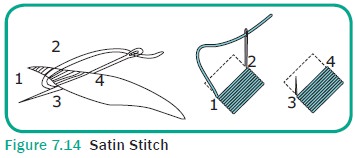Chapter: 11th Textiles and Dress Designing : Chapter 7 : Basic Stitches
Decorative Stitches
DECORATIVE STITCHES
Embroidery is the art of using decorative
stitches. With these stitches ornamen-tal motifs can be worked on almost all
soft surfaces. It is important to know all the basic embroidery stitches so
that the learner can effectively uses them for creat-ing beautiful design.
Stitches are selected based on the fabric and garment.
Stem Stitch
Description
·
It is a commonly used stitch in embroidery work.
·
It is used to complete the outline of any design.
·
It is also used as a filling stitch when worked
closely.
Method
·
Bring needle up at 1 on right side.
·
Take down needle at 2 to the wrong side and up at
3, half way between 1 and 2.
·
Insert needle and take needle just next to the
point 2.
·
The length of all the stitches should be the same
(Figure 7.5).

Straight Stitch
Description
·
These stitches can be worked in any direction.
·
The stitches are worked in varying sizes to
create an interesting effect.
·
This is worked on a evenly woven fabric.
·
It is also called as single satin stitch.
·
Right and wrong side of this stitch is similar.
Method
·
Bring needle up at 1 and insert at 2.
·
Again take needle up at 3 and insert at 4
·
It is better to work in same direction. For e.g.
bottom to top, or from top to bottom (Figure 7.6).

Fly Stitch
Description
·
These stitches can be worked hori-zontally or
vertically.
·
It is also used as a single detached stitch.
· It can be used well to cover a line or to do filling for a large space.
Method
·
Bring needle up at 1 and down at 2 leaving a loop
of thread.
·
Bring needle up at 3 inside the loop, insert down
at 4 outside the loop and catch a small straight stitch.
·
Repeat the process (Figure 7.7).

Seed Stitch
Description
·
This is a tiny running stitch.
·
It is used to fill small motifs or space.
Method
·
Bring needle up at 1 and insert at 2 catching a
tiny stitch.
·
Again bring needle up at 3 and take down at 4.
This should be made closer to the first stitch.
·
Repeat the process (Figure 7.8)

Cable Stitch
Description
·
It is also known as side to side hem stitch.
·
Looks like a brick stitch.
Method
·
Mark 4 points
·
1, 2, 3 and 4 on a straight line.
·
Take thread out at 1, insert at 3 and then take
out at 2.
·
To complete one set of stitch insert needle at 4
and take out at 3.
·
Continue stitching as per instruc-tions (Figure
7.9).

Chain Stitch
Description
·
It is formed by making series of loops.
·
It is the oldest of all stitches.
Method
·
Mark the points 1 and 2.
·
Take out needle at 1 and insert nee-dle at the
same point and take out needle at 2.
·
Before taking the needle out wind thread from
left to right and pull the needle gently to form a chain.
·
To continue the second chain insert needle at
point 2 and continue the sequence (Figure 7.10).

Lazy Daisy Stitch
Description
·
It is one of the detached stitches.
·
A single chain stitch form a lazy daisy stitch.
Method
·
Pull thread from point 1 and insert the needle at
the same point.
·
Take out needle at 2.
·
Wind thread from left to right, pull the needle
and lock the stitch at point 3 (Figure 7.11).

Magic Chain Stitch
Description
·
This is a variation of chain stitch.
·
Two coloured threads are used while stitching.
·
Chain stitches are created by winding alternate
colour threads. (Figure 7.12).

Blanket Stitch
Description
·
This stitch is used to finish the blan-ket edges.
·
It secures the edges and is stitched from left to
right or from right to left .
Method
·
Take needle at 1 and insert 2.
·
Lay thread parallel to point 1.
·
Insert needle at 2 and take out at 3.
·
Loop the thread around needle to from a stitch
(Figure 7.13).

Satin Stitch
Description
·
Satin stitch is a filling stitch.
·
It is used to cover small space.
·
This is a straight and flat stitch.
Method
·
Take needle at 1 and insert at 2.
·
Pull the needle at 3 and insert at 4.
·
Repeat the process and complete the filling of
any pattern (Figure 7.14)

Related Topics